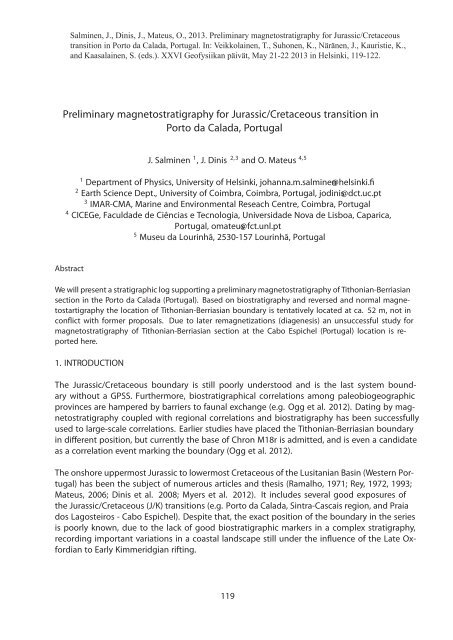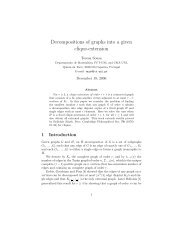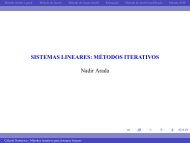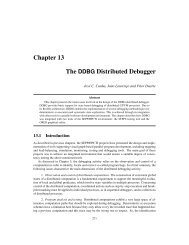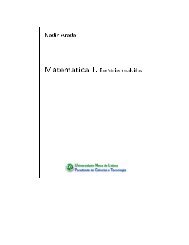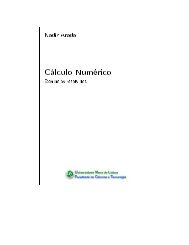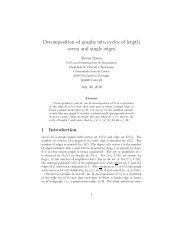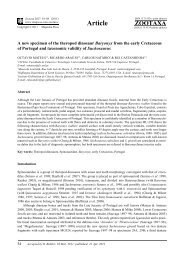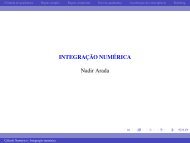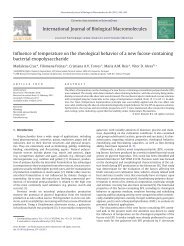Preliminary magnetostratigraphy for Jurassic/Cretaceous transition ...
Preliminary magnetostratigraphy for Jurassic/Cretaceous transition ...
Preliminary magnetostratigraphy for Jurassic/Cretaceous transition ...
You also want an ePaper? Increase the reach of your titles
YUMPU automatically turns print PDFs into web optimized ePapers that Google loves.
Salminen, J., Dinis, J., Mateus, O., 2013. <strong>Preliminary</strong> <strong>magnetostratigraphy</strong> <strong>for</strong> <strong>Jurassic</strong>/<strong>Cretaceous</strong><br />
<strong>transition</strong> in Porto da Calada, Portugal. In: Veikkolainen, T., Suhonen, K., Näränen, J., Kauristie, K.,<br />
and Kaasalainen, S. (eds.). XXVI Geofysiikan päivät, May 21-22 2013 in Helsinki, 119-122.<br />
<strong>Preliminary</strong> <strong>magnetostratigraphy</strong> <strong>for</strong> <strong>Jurassic</strong>/<strong>Cretaceous</strong> <strong>transition</strong> in<br />
Porto da Calada, Portugal<br />
J. Salminen 1 , J. Dinis 2,3 and O. Mateus 4,5<br />
1 Department of Physics, University of Helsinki, johanna.m.salminen@helsinki.fi<br />
2 Earth Science Dept., University of Coimbra, Coimbra, Portugal, jodinis@dct.uc.pt<br />
3 IMAR-CMA, Marine and Environmental Reseach Centre, Coimbra, Portugal<br />
4 CICEGe, Faculdade de Ciências e Tecnologia, Universidade Nova de Lisboa, Caparica,<br />
Portugal, omateus@fct.unl.pt<br />
5 Museu da Lourinhã, 2530-157 Lourinhã, Portugal<br />
Abstract<br />
We will present a stratigraphic log supporting a preliminary <strong>magnetostratigraphy</strong> of Tithonian-Berriasian<br />
section in the Porto da Calada (Portugal). Based on biostratigraphy and reversed and normal magnetostartigraphy<br />
the location of Tithonian-Berriasian boundary is tentatively located at ca. 52 m, not in<br />
conflict with <strong>for</strong>mer proposals. Due to later remagnetizations (diagenesis) an unsuccessful study <strong>for</strong><br />
<strong>magnetostratigraphy</strong> of Tithonian-Berriasian section at the Cabo Espichel (Portugal) location is reported<br />
here.<br />
1. INTRODUCTION<br />
The <strong>Jurassic</strong>/<strong>Cretaceous</strong> boundary is still poorly understood and is the last system boundary<br />
without a GPSS. Furthermore, biostratigraphical correlations among paleobiogeographic<br />
provinces are hampered by barriers to faunal exchange (e.g. Ogg et al. 2012). Dating by <strong>magnetostratigraphy</strong><br />
coupled with regional correlations and biostratigraphy has been successfully<br />
used to large-scale correlations. Earlier studies have placed the Tithonian-Berriasian boundary<br />
in dierent position, but currently the base of Chron M18r is admitted, and is even a candidate<br />
as a correlation event marking the boundary (Ogg et al. 2012).<br />
The onshore uppermost <strong>Jurassic</strong> to lowermost <strong>Cretaceous</strong> of the Lusitanian Basin (Western Portugal)<br />
has been the subject of numerous articles and thesis (Ramalho, 1971; Rey, 1972, 1993;<br />
Mateus, 2006; Dinis et al. 2008; Myers et al. 2012). It includes several good exposures of<br />
the <strong>Jurassic</strong>/<strong>Cretaceous</strong> (J/K) <strong>transition</strong>s (e.g. Porto da Calada, Sintra-Cascais region, and Praia<br />
dos Lagosteiros - Cabo Espichel). Despite that, the exact position of the boundary in the series<br />
is poorly known, due to the lack of good biostratigraphic markers in a complex stratigraphy,<br />
recording important variations in a coastal landscape still under the influence of the Late Ox<strong>for</strong>dian<br />
to Early Kimmeridgian rifting.<br />
119
Figure 1: Stratigraphy of the Porto da Calada section (Portugal): variation of magnetic susceptibility,<br />
intensity, inclination of ChRM, polarity column and M-anomalies. Black (white)<br />
indicates normal (reversed) polarity.<br />
2. SAMPLING AND METHODS<br />
We collected 102 standard cores from the Porto da Calada section (39.04 ◦ N; 9.41 ◦ E), and<br />
72 standard cores and four oriented block samples from the Cabo Espichel section (38.42 ◦ N;<br />
350.78 ◦ E). A portable field drill was used and cores were oriented using both sun and magnetic<br />
compasses.<br />
Paleomagnetic measurements <strong>for</strong> magnetostartigraphy were conducted in the magnetically shielded<br />
room of the paleomagnetic laboratory of the Department of Geology and Geophysics<br />
at the Yale University, USA. After measurement of natural remanent magnetization (NRM),<br />
samples were placed into liquid nitrogen in a null field to demagnetize viscous remanent magnetization<br />
(Borradaile et al. 2004). Thereafter to separate the characteristic remanent magnetization<br />
(ChRM) component the samples were stepwise thermally demagnetized in a nitrogenatmosphere<br />
using ASC Scientific model TD-48SC furnace. Remanent magnetization was measured<br />
using an automated sample-changing system attached to a 2G cryogenic magnetometer<br />
(Kirschvink et al. 2008). Results were analyzed using principal component analysis (Jones,<br />
2002). Sister specimens from the same cores were stepwise demagnetized using the alternating<br />
field (AF) method and a 2G cryogenic magnetometer in the Solid Earth Geophysics laboratory<br />
of the University of Helsinki. Due to high coercivity minerals in some of the samples the<br />
thermal method was more effective.<br />
120
3. RESULTS OF MAGNETIC STUDIES<br />
The natural remanent magnetization (NRM) intensity was generally in order of 10 −3 A/m and<br />
magnetic susceptibility in order of 10 −4 SI being typical <strong>for</strong> sedimentary rocks. NRM and<br />
susceptibility values depend on lithology and limestone show lowest values (Figure 1). Based<br />
on thermomagnetic (Curie point measurements) and thermal demagnetization main ferrimagnetic<br />
minerals in these samples are magnetite and pyrhhotite. Many of the samples were totally<br />
cleaned during the thermal demagnetization and vectors decayed to origin indicating that<br />
ChRM was successfully obtained and no higher coercivity/unblocking temperature component<br />
were present. Normal and reversed ChRM directions were obtained.<br />
We sampled a 65 meters thick section at Cabo Espichel <strong>for</strong> <strong>magnetostratigraphy</strong> but it was<br />
almost totally remagnetized by later processes. Samples were losing most of their magnetization<br />
at 180-240 ◦ C during thermal cleaning. AF method was not able to demagnetize samples<br />
indicating presence of high coercivity ferrimagnetic minerals (goethite).<br />
4. STRATIGRAPHY<br />
Since the results from Cabo Espichel cannot be used <strong>for</strong> sin-sedimentary stratigraphic purposes,<br />
this outcrop is not discussed here.<br />
Concerning the Porto da Calada section, the Assenta member of the Lourinhã Fm. is Tithonian<br />
in age. The Lourinhã Fm. is Kimmeridgian-Tithonian in age, confidently biostratigraphically<br />
dated by numerous invertebrates and vertebrates (see Mateus, 2006; Ribeiro and Mateus, 2012)<br />
and by strontium stable isotope curves (Schneider et al. 2009). The <strong>for</strong>aminifera, namely Anchispirocyclina<br />
lusitanica (Egger, 1902), and ostracods of the 37-40 m limestone level (Figure 1,<br />
Rey, 1972) are similar to the regional Tithonian assemblages (Ramalho, 1971). Dinocysts of the<br />
65-73 m interval are considered as representing early to middle Berriasian boundary (Berthou<br />
and Leereveld, 1990). The uncon<strong>for</strong>mity between the Porto da Calada and Vale de Lobos <strong>for</strong>mations<br />
is dated by regional tectono-stratigraphic correlation as Late Berriasian (Dinis et al.<br />
2008). In this section, two dinosaurs were identified: axial and postcrania of Ankylosauria below<br />
the J/K limit, and one tail spine of Stegosauridae above it, both chronologically consistent<br />
with the <strong>magnetostratigraphy</strong>.<br />
5. DISCUSSION AND CONCLUSIONS<br />
Based on these we correlate the reversed magnetozone at 33 m in log with M19r1 anomaly and<br />
normal magnetozone between 35 and 51 m with M19n1 (Fig. 1). Following the (Ogg et al.<br />
2012) scale, we place the J/K Tithonian-Berriasian boundary at the base of magnetozone M18r,<br />
around 52 m of our log in Porto da Calada section.This position is an improvement of previous<br />
proposals <strong>for</strong> this outcrop, namely by Rey (1993), that tentatively located the J/K boundary at<br />
the base of the Porto da Calada Formation (our 60 m) as a best fit between available biostratigraphy<br />
and regional correlations. However, it must be stressed that the proposed position of the<br />
J/K boundary is tentative, due to scarcity and uncertainties in the age significance of fossils in<br />
the studied series.<br />
121
ACKNOWLEDGEMENTS<br />
Ms Krista Haavisto and Ms Iiris Viljamaa are thanked <strong>for</strong> their help during the laboratory work.<br />
Johanna Salminen was funded by the Finnish Cultural Foundation.<br />
REFERENCES<br />
Berthou P.-Y. and H. Leereveld, 1990. Stratigraphic implications of palynological studies on<br />
Berriasian to Albian deposits from western and southern Portugal. Review of Palaeobotany<br />
and Palynology, 66, 313-344.<br />
Borradaile G.J., K. Luca K. and R.S. Middleton, 2004. Low-temperature demagnetization isolates<br />
stable magnetic vector components in magnetite-bearing diabase. Geophys. J. Int.,<br />
157, 526-536.<br />
Dinis J.L., J. Rey, P.P. Cunha, P.M. Callapez and R.P. Reis, 2008. Stratigraphy and allogenic<br />
controls on the western Portugal <strong>Cretaceous</strong>: an updated synthesis. <strong>Cretaceous</strong> Research,<br />
29, 772-780.<br />
Jones C.H., 2002. User-driven Integrated Software Lives: "PaleoMag" Paleomagnetics Analysis<br />
on the Macintosh. Comput. Geosci, 28, 1145-1151.<br />
Kirschvink J.L., R.E. Kopp, T.D. Raub, C.T. Baumgartner and J.W. Holt, 2008. Rapid, precise,<br />
and high-sensitivity acquisition of paleomagnetic and rock-magnetic data: Development<br />
of a low-noise automatic sample changing system <strong>for</strong> superconducting rock magnetometers.<br />
Geochem. Geophys. Geosyst., 9, Q05Y01.<br />
Mateus, O., 2006. Late <strong>Jurassic</strong> dinosaurs from the Morrison <strong>for</strong>mation , USA), the Lourinhã<br />
and Alcobaça Formations (Portugal), and the Tendaguru Beds (Tanzania): a comparison.<br />
New Mexico Museum of Natural History and Science Bulletin, 36, 223-231.<br />
Myers, T.S., N.J. Tabor, L.L. Jacobs and O. Mateus, 2012. Palaeoclimate of the Late <strong>Jurassic</strong> of<br />
Portugal: comparison with the Western United States. Sedimentology, 59, 1695–1717.<br />
Ogg, J.G., L.A. Hinnov and C. Huang, 2012. <strong>Cretaceous</strong>. In: The Geologic Time Scale 2012,<br />
vol. 2, ed. Gradstein et al., pp. 793-853.<br />
Ramalho M.M., 1971. Contribution à l’étude micropaléontologique et stratigraphique du Jurassique<br />
Superieur et Crétacé inferieur des environs de Lisbonne (Portugal). Mem. Serv.<br />
Geol. Portugal, 19 (N.S.), 212 pp.<br />
Rey J., 1972. Recherches géologiques sur le Crétacé inférieur de l’Estremadura (Portugal).<br />
Mem. Serv. Geol. Portugal, 21 (N.S.), 477 pp.<br />
Rey J., 1993. Les unités lithostratigraphiques du Grupe de Torres Vedras (Estremadura, Portugal).<br />
Com. Inst. Geol. Min., 79, 75-85.<br />
Ribeiro, V. and O. Mateus, 2012. Chronology of the Late <strong>Jurassic</strong> dinosaur faunas, and other<br />
reptilian faunas, from Portugal. Journal of Vertebrate Paleontology, Program and Abstracts,<br />
2012, p. 161.<br />
122


